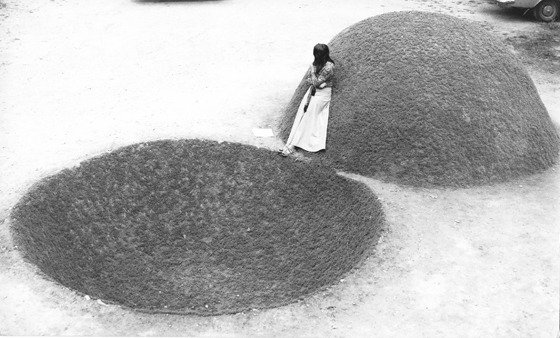Transformations
dal 17/1/2014 al 28/2/2014
Segnalato da
17/1/2014
Transformations
Galerie Campagne Premiere, Berlin
Teresa Murak, Ingeborg Luscher, Ana Mendieta. The exhibition presents 3 women artists, who -even though they have been working in different countries and stem from different cultures- have been using the same subversive connotations of 'elemental' materials and unrefined, natural imagery.

The exhibition “Transformations” presents three women artists, who –even though they have been working in different countries and stem from different cultures– have been using the same subversive connotations of “elemental” materials and unrefined, natural imagery. The exhibition sheds light on their singular relationship with nature, focusing as much on their female perspective of the world as on their straight and concise use of contemporary art vocabulary of the 1970s and 1980s.
The exhibition elaborates on the artists‘ use of photography and film and features works by Cuban-American artist Ana Mendieta (*1948-1985), Swiss-German artist Ingeborg Lüscher (*1936) and Polish artist Teresa Murak (*1949).
Teresa Murak is considered –along with Natalia LL and Ewa Partum– one of the leading performance and body artists in Poland since the 1970s. At the beginning of the 1970s, she discovered the natural material that was to become central to her artistic practice: plant seeds. After martial law was declared in Poland in the 1980s, she was forced to transfer her activities to the artistic underground.
In 1975, Teresa Murak created the signature work of her artistic practice: “Lady’s Smock”, a dress made out of fast-growing cress seeds. Here, Murak’s nude body constitutes both subject and art material interacting with natural elements. The large-scale “Lady’s Smock” photos on display stem from an 8mm film recording that no longer exists except for a few prints made from the original film, each of which constitutes a unique copy.
She revived the quintessentially performative potential of her material of choice in an original manner at the end of the 1980s with a project which required Murak to remain in a bathtub filled with soaked seeds until these would sprout. (Centre for Polish Sculpture, Oronsko 1989; Künstlerhaus Bethanien, Berlin 1989; PS 1 Gallery, New York 1991). The color and texture of these “carpets” of vegetation constitute an essential formal and aesthetic element throughout Murak’s works, including her video work.
Ingeborg Lüscher began her artistic career in the late 1960s, following up on her work as an actress and as a student of psychology. Her oeuvre is characterized by her use of unconventional material, which has a high symbolic value. Her photographic series can be interpreted as investigations into transience and durability.
Two central works from the late 1970s will be shown in the exhibition. The photoseries “How I Begin to See the World, or: I Know the Meaning and the Words, Only the Things Are Above Me” is arranged as a pyramid and was first shown at the 39th Venice Biennale in 1980. The work shows the way a child perceives its environment. The proportions suggest how the child is unable to grasp the size and scope of the world around them.
The work “Re-” followed Lüscher’s attempts to find out about past lives under hypnosis. The artist subsequently took photos of her own reflection in the mirror on twelve occasions, wearing alternating –and improvised– pieces of headgear.
Lüscher displays a similarly playful engagement with the metaphysical in the video piece “La Pupa Proibita”. “La Pupa”, a tremendous female figure from Abbruzzo folklore, becomes the embodiment of what is desired from life.
Ana Mendieta is widely known for her works in nature, where she exposes her body in different landscapes. A comprehensive overview of her work opened at the Hayward Gallery in London at the end of last year and will also be on view at the Museum der Moderne in Salzburg from the end of March 2014 onwards.
During her short career, Ana Mendieta created a body of work that was radically inventive and influenced the next generation of artists such as Cindy Sherman and Francesca Woodman. By using her own body and combining it with elemental materials –blood, fire, earth and water– she created ephemeral “Earth-Body” sculptures that explored life, death and transformation. Questioning the way in which “Earth Art” tended to dominate its surrounding landscape, she preferred to use the term "Earth-Body" better to fit the ephemeral aspect of her interventions.
Between 1973 and 1980, Ana Mendieta created a series of works, collectively entitled “Silueta”, which were created during her travels between Iowa (USA) and Mexico. They have the formal element of the artist’s silhouette in common, which is represented by and filled with organic materials. Three films by Ana Mendieta will be shown in the exhibition. The two “firework-films” –“Alma Silueta en Fuego” and “Untitled (Gunpowder Work #2)”– are based on Ana Mendieta’s “Earth-Body”-works in which she traces her body with fire, fruit, earth, candles and stones. She actively transforms the landscape by integrating her ghost-like silhouette with nature through this symbiotic gesture.
The rarely shown 8mm-film “Butterfly” captures the essence of her artistic research. In this experimental film the artist becomes a butterfly, a symbol of the psyche and of metamorphosis (“ψυχn“ – “psyche“ is the Ancient Greek word for both butterfly and the soul).
Image: Teresa Murak, Rzezba dla Ziemi (Sculpture for the Earth), Ubbeboda Center (Sweden) 1974, b&w photograph, 14 x 23.3 cm
Campagne Première GmbH
Chausseestrasse 116 D-10115 Berlin
Hours: Tue - Sat 11am - 6pm



